Bile Peng
RIS-Assisted NOMA with Partial CSI and Mutual Coupling: A Machine Learning Approach
Aug 12, 2025



Abstract:Non-orthogonal multiple access (NOMA) is a promising multiple access technique. Its performance depends strongly on the wireless channel property, which can be enhanced by reconfigurable intelligent surfaces (RISs). In this paper, we jointly optimize base station (BS) precoding and RIS configuration with unsupervised machine learning (ML), which looks for the optimal solution autonomously. In particular, we propose a dedicated neural network (NN) architecture RISnet inspired by domain knowledge in communication. Compared to state-of-the-art, the proposed approach combines analytical optimal BS precoding and ML-enabled RIS, has a high scalability to control more than 1000 RIS elements, has a low requirement for channel state information (CSI) in input, and addresses the mutual coupling between RIS elements. Beyond the considered problem, this work is an early contribution to domain knowledge enabled ML, which exploit the domain expertise of communication systems to design better approaches than general ML methods.
A Scalable Machine Learning Approach Enabled RIS Optimization with Implicit Channel Estimation
Aug 10, 2025Abstract:The reconfigurable intelligent surface (RIS) is considered as a key enabler of the next-generation mobile radio systems. While attracting extensive interest from academia and industry due to its passive nature and low cost, scalability of RIS elements and requirement for channel state information (CSI) are two major difficulties for the RIS to become a reality. In this work, we introduce an unsupervised machine learning (ML) enabled optimization approach to configure the RIS. The dedicated neural network (NN) architecture RISnet is combined with an implicit channel estimation method. The RISnet learns to map from received pilot signals to RIS configuration directly without explicit channel estimation. Simulation results show that the proposed algorithm outperforms baselines significantly.
5G Channel Models for Railway Use Cases at mmWave Band and the Path Towards Terahertz
Jan 28, 2025



Abstract:High-speed trains are one of the most relevant scenarios for the fifth-generation (5G) mobile communications and the "smart rail mobility" vision, where a high-data-rate wireless connectivity with up to several GHz bandwidths will be required. This is a strong motivation for the exploration of millimeter wave (mmWave) band. In this article, we identify the main challenges and make progress towards realistic 5G mmWave channel models for railway use cases. In order to cope with the challenge of including the railway features in the channel models, we define reference scenarios to help the parameterization of channel models for railway use at mmWave band. Simulations and the subsequent measurements used to validate the model reflect the detailed influence of railway objects and the accuracy of the simulations. Finally, we point out the future directions towards the full version of the smart rail mobility which will be powered by terahertz (THz) communications.
Distributed Combinatorial Optimization of Downlink User Assignment in mmWave Cell-free Massive MIMO Using Graph Neural Networks
Jun 09, 2024



Abstract:Millimeter wave (mmWave) cell-free massive MIMO (CF mMIMO) is a promising solution for future wireless communications. However, its optimization is non-trivial due to the challenging channel characteristics. We show that mmWave CF mMIMO optimization is largely an assignment problem between access points (APs) and users due to the high path loss of mmWave channels, the limited output power of the amplifier, and the almost orthogonal channels between users given a large number of AP antennas. The combinatorial nature of the assignment problem, the requirement for scalability, and the distributed implementation of CF mMIMO make this problem difficult. In this work, we propose an unsupervised machine learning (ML) enabled solution. In particular, a graph neural network (GNN) customized for scalability and distributed implementation is introduced. Moreover, the customized GNN architecture is hierarchically permutation-equivariant (HPE), i.e., if the APs or users of an AP are permuted, the output assignment is automatically permuted in the same way. To address the combinatorial problem, we relax it to a continuous problem, and introduce an information entropy-inspired penalty term. The training objective is then formulated using the augmented Lagrangian method (ALM). The test results show that the realized sum-rate outperforms that of the generalized serial dictatorship (GSD) algorithm and is very close to the upper bound in a small network scenario, while the upper bound is impossible to obtain in a large network scenario.
RISnet: A Domain-Knowledge Driven Neural Network Architecture for RIS Optimization with Mutual Coupling and Partial CSI
Mar 06, 2024



Abstract:Multiple access techniques are cornerstones of wireless communications. Their performance depends on the channel properties, which can be improved by reconfigurable intelligent surfaces (RISs). In this work, we jointly optimize MA precoding at the base station (BS) and RIS configuration. We tackle difficulties of mutual coupling between RIS elements, scalability to more than 1000 RIS elements, and channel estimation. We first derive an RIS-assisted channel model considering mutual coupling, then propose an unsupervised machine learning (ML) approach to optimize the RIS. In particular, we design a dedicated neural network (NN) architecture RISnet with good scalability and desired symmetry. Moreover, we combine ML-enabled RIS configuration and analytical precoding at BS since there exist analytical precoding schemes. Furthermore, we propose another variant of RISnet, which requires the channel state information (CSI) of a small portion of RIS elements (in this work, 16 out of 1296 elements) if the channel comprises a few specular propagation paths. More generally, this work is an early contribution to combine ML technique and domain knowledge in communication for NN architecture design. Compared to generic ML, the problem-specific ML can achieve higher performance, lower complexity and symmetry.
Energy-Efficient Power Allocation in Cell-Free Massive MIMO via Graph Neural Networks
Feb 01, 2024



Abstract:CF-mMIMO systems are a promising solution to enhance the performance in 6G wireless networks. Its distributed nature of the architecture makes it highly reliable, provides sufficient coverage and allows higher performance than cellular networks. EE is an important metric that reduces the operating costs and also better for the environment. In this work, we optimize the downlink EE performance with MRT precoding and power allocation. Our aim is to achieve a less complex, distributed and scalable solution. To achieve this, we apply unsupervised ML with permutation equivariant architecture and use a non-convex objective function with multiple local optima. We compare the performance with the centralized and computationally expensive SCA. The results indicate that the proposed approach can outperform the baseline with significantly less computation time.
Non-Orthogonal Multiple Access Assisted by Reconfigurable Intelligent Surface Using Unsupervised Machine Learning
May 01, 2023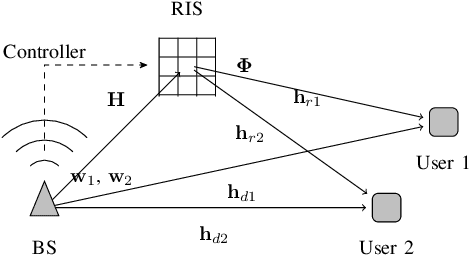

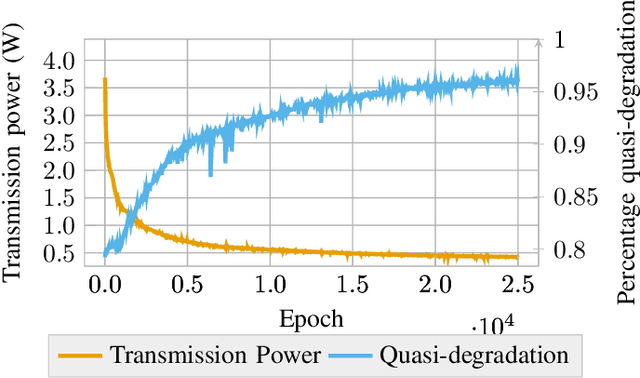
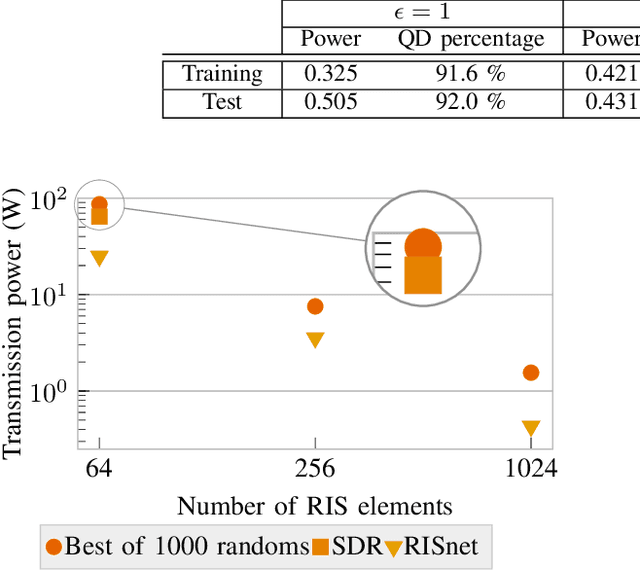
Abstract:Nonorthogonal multiple access (NOMA) with multi-antenna base station (BS) is a promising technology for next-generation wireless communication, which has high potential in performance and user fairness. Since the performance of NOMA depends on the channel conditions, we can combine NOMA and reconfigurable intelligent surface (RIS), which is a large and passive antenna array and can optimize the wireless channel. However, the high dimensionality makes the RIS optimization a complicated problem. In this work, we propose a machine learning approach to solve the problem of joint optimization of precoding and RIS configuration. We apply the RIS to realize the quasi-degradation of the channel, which allows for optimal precoding in closed form. The neural network architecture RISnet is used, which is designed dedicatedly for RIS optimization. The proposed solution is superior than the works in the literature in terms of performance and computation time.
RISnet: A Scalable Approach for Reconfigurable Intelligent Surface Optimization with Partial CSI
May 01, 2023



Abstract:The reconfigurable intelligent surface (RIS) is a promising technology that enables wireless communication systems to achieve improved performance by intelligently manipulating wireless channels. In this paper, we consider the sum-rate maximization problem in a downlink multi-user multi-input-single-output (MISO) channel via space-division multiple access (SDMA). Two major challenges of this problem are the high dimensionality due to the large number of RIS elements and the difficulty to obtain the full channel state information (CSI), which is assumed known in many algorithms proposed in the literature. Instead, we propose a hybrid machine learning approach using the weighted minimum mean squared error (WMMSE) precoder at the base station (BS) and a dedicated neural network (NN) architecture, RISnet, for RIS configuration. The RISnet has a good scalability to optimize 1296 RIS elements and requires partial CSI of only 16 RIS elements as input. We show it achieves a high performance with low requirement for channel estimation for geometric channel models obtained with ray-tracing simulation. The unsupervised learning lets the RISnet find an optimized RIS configuration by itself. Numerical results show that a trained model configures the RIS with low computational effort, considerably outperforms the baselines, and can work with discrete phase shifts.
RISNet: a Dedicated Scalable Neural Network Architecture for Optimization of Reconfigurable Intelligent Surfaces
Dec 06, 2022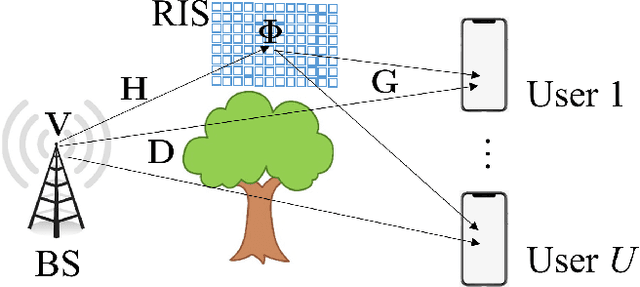

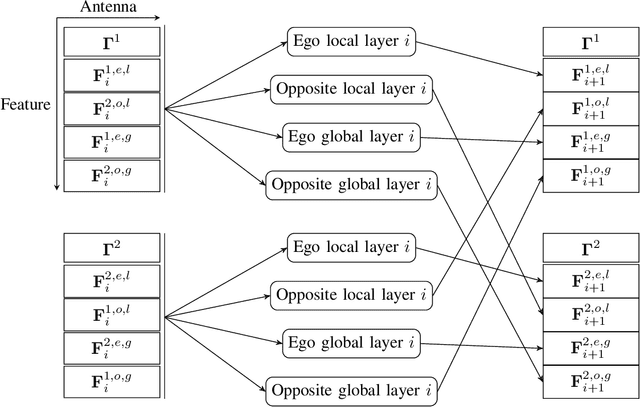
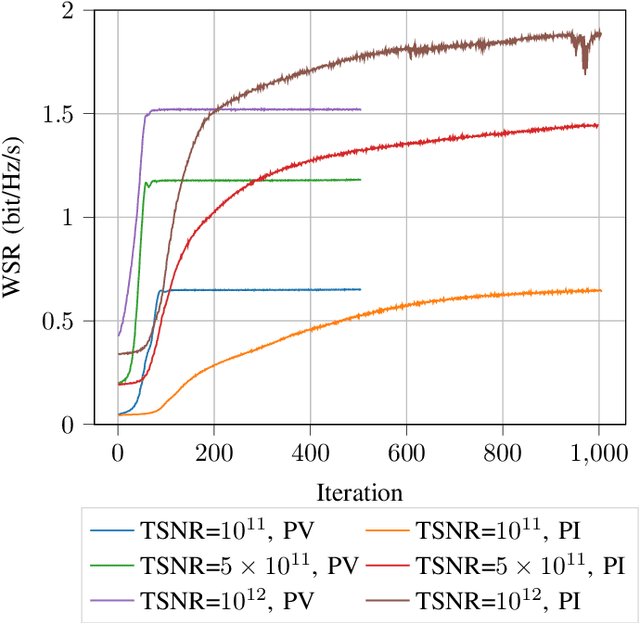
Abstract:The reconfigurable intelligent surface (RIS) is a promising technology for next-generation wireless communication. It comprises many passive antennas, which reflect signals from the transmitter to the receiver with adjusted phases without changing the amplitude. The large number of the antennas enables a huge potential of signal processing despite the simple functionality of a single antenna. However, it also makes the RIS configuration a high dimensional problem, which might not have a closed-form solution and has a high complexity and, as a result, severe difficulty in online real-time application if we apply iterative numerical solutions. In this paper, we introduce a machine learning approach to maximize the weighted sum-rate (WSR). We propose a dedicated neural network architecture called RISNet. The RIS optimization is designed according to the RIS property of product and direct channel and homogeneous RIS antennas. The architecture is scalable due to the fact that the number of trainable parameters is independent from the number of RIS antennas (because all antennas share the same parameters). The weighted minimum mean squared error (WMMSE) precoding is applied and an alternating optimization (AO) training procedure is designed. Testing results show that the proposed approach outperforms the state-of-the-art block coordinate descent (BCD) algorithm. Moreover, although the training takes several hours, online testing with trained model (application) is almost instant, which makes it feasible for real-time application. Compared to it, the BCD algorithm requires much more convergence time. Therefore, the proposed method outperforms the state-of-the-art algorithm in both performance and complexity.
Two-Hop Age of Information Scheduling for Multi-UAV Assisted Mobile Edge Computing: FRL vs MADDPG
Jun 19, 2022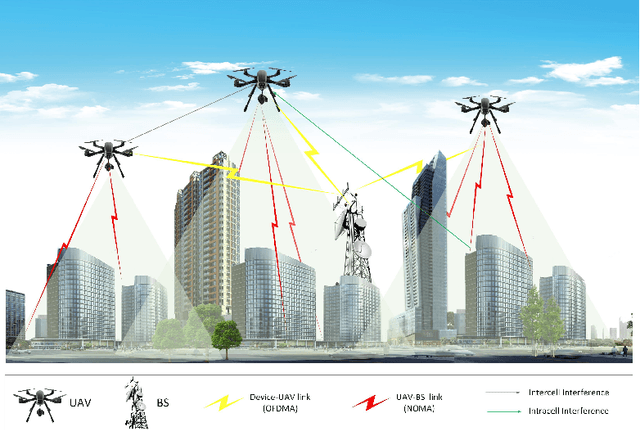
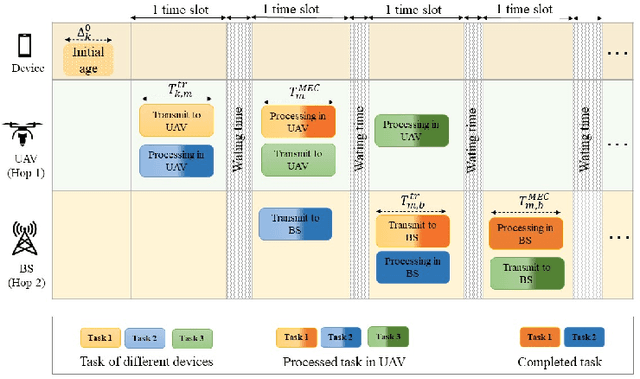
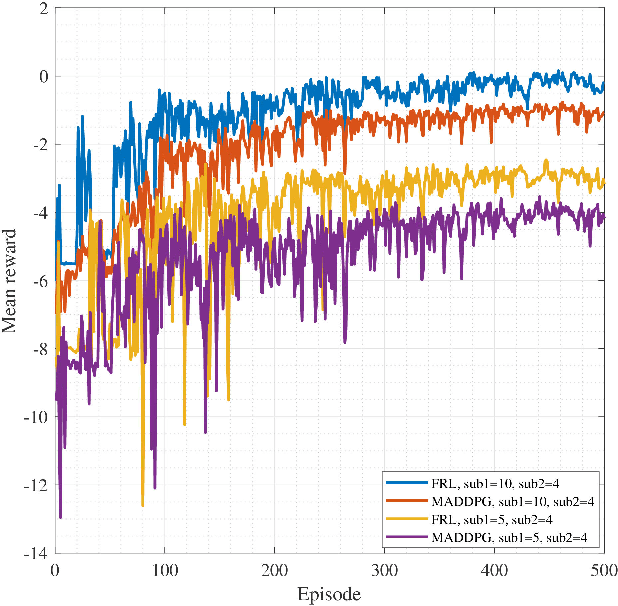
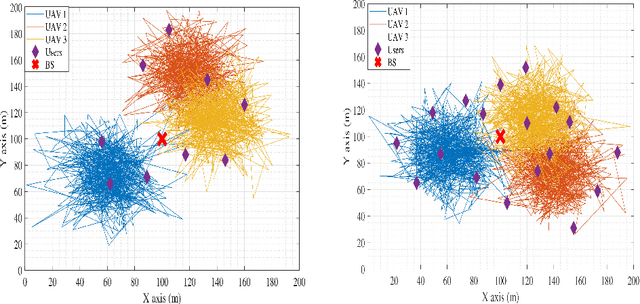
Abstract:In this work, we adopt the emerging technology of mobile edge computing (MEC) in the Unmanned aerial vehicles (UAVs) for communication-computing systems, to optimize the age of information (AoI) in the network. We assume that tasks are processed jointly on UAVs and BS to enhance edge performance with limited connectivity and computing. Using UAVs and BS jointly with MEC can reduce AoI on the network. To maintain the freshness of the tasks, we formulate the AoI minimization in two-hop communication framework, the first hop at the UAVs and the second hop at the BS. To approach the challenge, we optimize the problem using a deep reinforcement learning (DRL) framework, called federated reinforcement learning (FRL). In our network we have two types of agents with different states and actions but with the same policy. Our FRL enables us to handle the two-step AoI minimization and UAV trajectory problems. In addition, we compare our proposed algorithm, which has a centralized processing unit to update the weights, with fully decentralized multi-agent deep deterministic policy gradient (MADDPG), which enhances the agent's performance. As a result, the suggested algorithm outperforms the MADDPG by about 38\%
 Add to Chrome
Add to Chrome Add to Firefox
Add to Firefox Add to Edge
Add to Edge